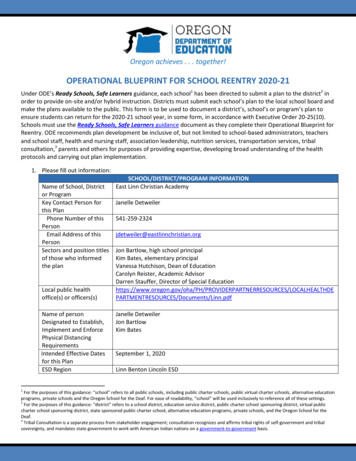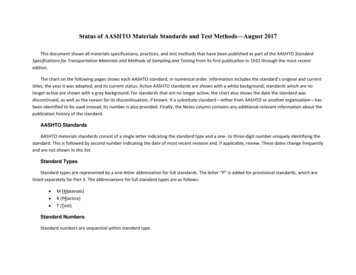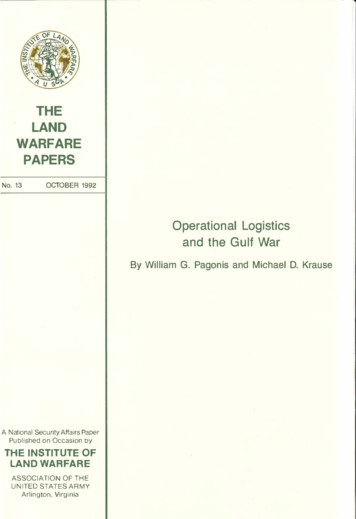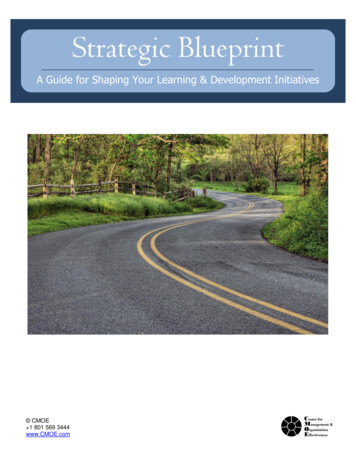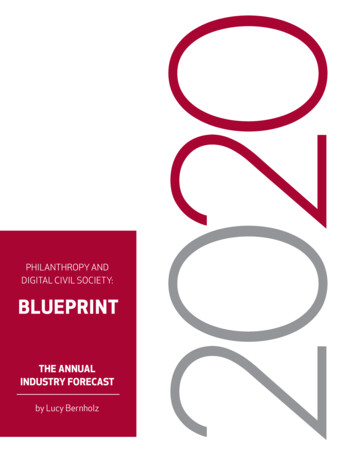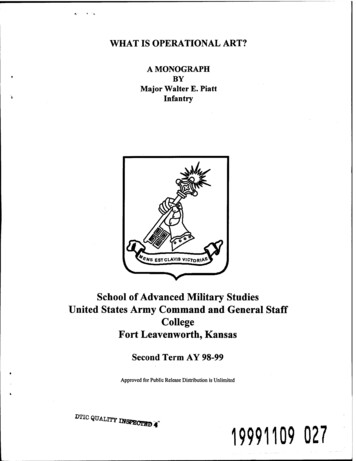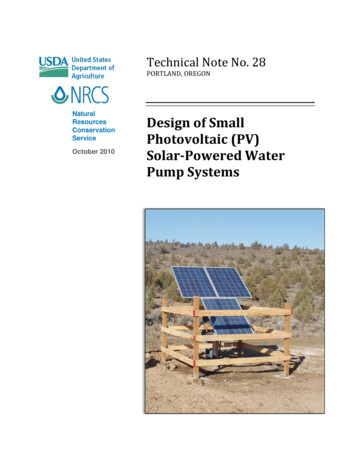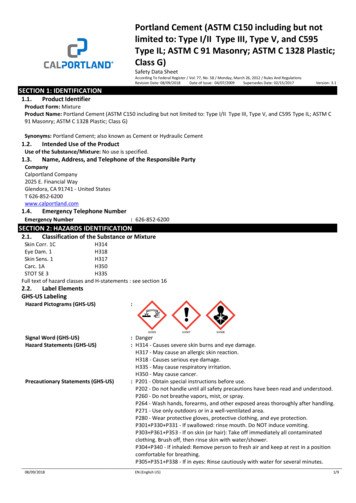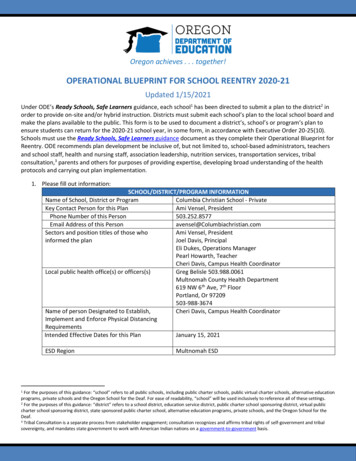
Transcription
Oregon achieves . . . together!OPERATIONAL BLUEPRINT FOR SCHOOL REENTRY 2020-21Updated 1/15/2021Under ODE’s Ready Schools, Safe Learners guidance, each school1 has been directed to submit a plan to the district2 inorder to provide on-site and/or hybrid instruction. Districts must submit each school’s plan to the local school board andmake the plans available to the public. This form is to be used to document a district’s, school’s or program’s plan toensure students can return for the 2020-21 school year, in some form, in accordance with Executive Order 20-25(10).Schools must use the Ready Schools, Safe Learners guidance document as they complete their Operational Blueprint forReentry. ODE recommends plan development be inclusive of, but not limited to, school-based administrators, teachersand school staff, health and nursing staff, association leadership, nutrition services, transportation services, tribalconsultation,3 parents and others for purposes of providing expertise, developing broad understanding of the healthprotocols and carrying out plan implementation.1. Please fill out information:SCHOOL/DISTRICT/PROGRAM INFORMATIONName of School, District or ProgramColumbia Christian School - PrivateKey Contact Person for this PlanAmi Vensel, PresidentPhone Number of this Person503.252.8577Email Address of this Personavensel@Columbiachristian.comSectors and position titles of those whoAmi Vensel, Presidentinformed the planJoel Davis, PrincipalEli Dukes, Operations ManagerPearl Howarth, TeacherCheri Davis, Campus Health CoordinatorLocal public health office(s) or officers(s)Greg Belisle 503.988.0061Multnomah County Health Department619 NW 6th Ave, 7th FloorPortland, Or 97209503-988-3674Name of person Designated to Establish,Cheri Davis, Campus Health CoordinatorImplement and Enforce Physical DistancingRequirementsIntended Effective Dates for this PlanJanuary 15, 2021ESD Region1Multnomah ESDFor the purposes of this guidance: “school” refers to all public schools, including public charter schools, public virtual charter schools, alternative educationprograms, private schools and the Oregon School for the Deaf. For ease of readability, “school” will be used inclusively to reference all of these settings.2 For the purposes of this guidance: “district” refers to a school district, education service district, public charter school sponsoring district, virtual publiccharter school sponsoring district, state sponsored public charter school, alternative education programs, private schools, and the Oregon School for theDeaf.3 Tribal Consultation is a separate process from stakeholder engagement; consultation recognizes and affirms tribal rights of self-government and tribalsovereignty, and mandates state government to work with American Indian nations on a government-to-government basis.
2. Please list efforts you have made to engage your community (public health information sharing, taking feedbackon planning, etc.) in preparing for school in 2020-21. Include information on engagement with communitiesoften underserved and marginalized and those communities disproportionately impacted by COVID-19.We conducted a survey of our students’ families and received timely and helpful feedback that has informedour decisions regarding reentry. We expanded our safety committee so that sub-committees couldcollaborate and contribute to our blueprint. We have had several Zoom Q & A sessions with parents andfamilies. We send out weekly email communications from our President detailing updates.3. Indicate which instructional model will be used.Select One: On-Site Learning Hybrid Learning Comprehensive Distance Learning4. If you selected Comprehensive Distance Learning, you only have to fill out the green portion of the OperationalBlueprint for Reentry (i.e., page 2 in the initial template).5. If you selected On-Site Learning or Hybrid Learning, you have to fill out the blue portion of the OperationalBlueprint for Reentry (i.e., pages 3-19 in the initial template) and submit 85d94966b1dffc75e4874c8a) by August 17, 2020 or prior to thebeginning of the 2020-21 school year.* Note: Private schools are required to comply with only sections 1-3 of the Ready Schools, Safe Learners guidance.REQUIREMENTS FOR COMPREHENSIVE DISTANCE LEARNING OPERATIONAL BLUEPRINTThis section must be completed by any school that is seeking to provide instruction through Comprehensive Distance Learning. For Private Schools,completing this section is optional (not required). Schools providing On-Site or Hybrid Instructional Models do not need to complete this section.Describe why you are selecting Comprehensive Distance Learning as the school’s Instructional Model for the effective dates of this plan.In completing this portion of the Blueprint you are attesting that you have reviewed the Comprehensive Distance Learning Guidance. Here isa link to the overview of CDL Requirements. Please name any requirements you need ODE to review for any possible flexibility or waiver.Page 2 of 23
Describe the school’s plan, including the anticipated timeline, for returning to Hybrid Learning or On-Site Learning consistent with the ReadySchools, Safe Learners guidance.The remainder of this operational blueprint is not applicable to schools operating a Comprehensive Distance Learning Model.ESSENTIAL REQUIREMENTS FOR HYBRID / ON-SITE OPERATIONAL BLUEPRINTThis section must be completed by any school that is providing instruction through On-Site or Hybrid Instructional Models.Schools providing Comprehensive Distance Learning Instructional Models do not need to complete this section unless the school is implementingthe Limited In-Person Instruction provision under the Comprehensive Distance Learning guidance.0. Health Metrics for Returning to In-Person Instruction OPERATING WITHIN THE GENERAL METRICSThe school meets eligibility for the “Safe Harbor Clause” as they were operating with in-person instruction in compliance with previousmetrics, including under any prior exceptions. Unless operating under an exception in section 0d of the Ready Schools, Safe Learnersguidance, if the school is located in a county with metrics in the “Distance Learning” column of the metrics chart, then the school musttransition to distance learning by January 4, 2021.The school currently meets the General Metrics to successfully reopen for in-person instruction in an On-Site or Hybrid (On-Site andDistance Learning) model. If this box cannot yet be checked, the school must return to Comprehensive Distance Learning but may be able toprovide some in-person instruction through the exceptions noted below.EXCEPTIONS FOR SPECIFIC IN-PERSON INSTRUCTION WHERE REQUIRED CONDITIONS ARE METThe school currently meets the criteria required to provide limited in-person instruction (LIPI) for specific groups of students (see section0d(1) of the Ready Schools, Safe Learners guidance).The school is small and remote (enrollment 75) and the LPHA has established that the school currently meets the criteria required forsmall remote schools (see section 0d(2) of the Ready Schools, Safe Learners guidance).The school currently meets the conditions required for to provide in-person instruction under the low population density, large populationcounty exception (see section 0d(3) of the Ready Schools, Safe Learners guidance).The school is eligible for an emergency waiver for in-person instruction due to the impact of wildfires (see section 0d(4) of the ReadySchools, Safe Learners guidance).1. Public Health Protocols1a. COMMUNICABLE DISEASE MANAGEMENT PLAN FOR COVID-19OHA/ODE RequirementsHybrid/Onsite Plan Implement measures to limit the spread of COVID-19 within theschool setting.Columbia uses the Multnomah Education Service District Update written Communicable Disease Management Plan toCommunicable Disease Management Plan that is located here.specifically address the prevention of the spread of COVID-19.Examples are located in the Oregon School Nurses Association(OSNA) COVID-19 Toolkit.Page 3 of 23
OHA/ODE Requirements Designate a person at each school to establish, implement andenforce physical distancing requirements, consistent with thisguidance and other guidance from OHA. Include names of the LPHA staff, school nurses, and other medicalexperts who provided support and resources to the district/schoolpolicies and plans. Review relevant local, state, and nationalevidence to inform plan. Process and procedures established to train all staff in sections 1 3 of the Ready Schools, Safe Learners guidance. Considerconducting the training virtually, or, if in-person, ensure physicaldistancing is maintained to the maximum extent possible. Protocol to notify the local public health authority (LPHA Directoryby County) of any confirmed COVID-19 cases among students orstaff. Plans for systematic disinfection of classrooms, offices, bathroomsand activity areas. Process to report to the LPHA any cluster of any illness among staffor students. Protocol to cooperate with the LPHA recommendations. Provide all logs and information to the LPHA in a timely manner. Protocol for screening students and staff for symptoms (seesection 1f of the Ready Schools, Safe Learners guidance). Protocol to isolate any ill or exposed persons from physical contactwith others. Protocol for communicating potential COVID-19 cases to theschool community and other stakeholders (see section 1e of theReady Schools, Safe Learners guidance). Create a system for maintaining daily logs for each student/cohortfor the purposes of contact tracing. This system needs to be madein consultation with a school/district nurse or an LPHA official.Sample logs are available as a part of the Oregon School NursesAssociation COVID-19 Toolkit. If a student(s) is part of a stable cohort (a group of studentsthat are consistently in contact with each other or in multiplecohort groups) that conform to the requirements of cohorting(see section 1d of the Ready Schools, Safe Learnersguidance), the daily log may be maintained for the cohort. If a student(s) is not part of a stable cohort, then an individualstudent log must be maintained. Required components of individual daily student/cohort logsinclude: Child’s name Drop off/pick up time Parent/guardian name and emergency contact information All staff (including itinerant staff, district staff, substitutes,and guest teachers) names and phone numbers who interactwith a stable cohort or individual student Protocol to record/keep daily logs to be used for contact tracingfor a minimum of four weeks to assist the LPHA as needed. Process to ensure that all itinerant and all district staff(maintenance, administrative, delivery, nutrition, and any otherstaff) who move between buildings keep a log or calendar with arunning four-week history of their time in each school building andwho they were in contact with at each site. Process to ensure that the school reports to and consults with theLPHA regarding cleaning and possible classroom or programclosure if anyone who has entered school is diagnosed with COVID19. Designate a staff member and process to ensure that the schoolprovides updated information regarding current instructionalHybrid/Onsite PlanCampus Health Coordinator is responsible for establishing,implementing and enforcing physical distancing requirements.LPHA contactGreg Belisle, f Training: All staff will receive comprehensive training via Zoomin sections 1-3 prior to school starting LIPI and also prior to startingthe hybrid model. Ongoing training and reminders will occur asneeded.Student Training: All students will receive guidance and training onthe safety protocols at the start of LIPI and again as we start thehybrid model. Ongoing training and reminders will happenthroughout the year.Cleaning Protocols: Disinfection protocols are outlined in section 2d.Screening/Isolation: Health screen protocols are outlined in section1F. Potentially symptomatic students will be isolated followingguidance in 1I.Outbreak/Communication Plan: Columbia’s outbreak plan is outlinedin section 3b.Contact Tracing/ Daily Logs: Contact tracing and daily logs will bekept for all students and will include all necessary requiredcomponents. Records will be kept for a minimum of 4 weeks andshared with LPHA when neededItinerant/Staff: All staff who move between buildings will be requiredto sign in to a tracking log detailing their time in each building andwho they came in contact with.Campus Health Coordinator will provide updates to ODE’s COVID-19Weekly School Status UpdateColumbia will use ODE’s Planning for COVID-19 Scenarios in Schoolsdocument when responding to potential outbreaksPage 4 of 23
OHA/ODE Requirementsmodels and student counts and reports these data in ODE’s COVID19 Weekly School Status system. Protocol to respond to potential outbreaks (see section 3 of theReady Schools, Safe Learners guidance).Hybrid/Onsite Plan1b. HIGH-RISK POPULATIONSOHA/ODE RequirementsHybrid/Onsite PlanAll staff and students are given the opportunity to self-identify as Serve students in high-risk population(s) whether learning ishappening through On-Site, Hybrid (partially On-Site and partiallyvulnerable or as part of a vulnerable household.Comprehensive Distance Learning models), or ComprehensiveDistance Learning models.StaffRedeployed staff members can be assigned to:Medically Fragile, Complex and Nursing-Dependent Student On-line instruction and supportRequirements Maintenance projects, custodial work, office work without All districts must account for students who have health conditionsstudent/staff contactthat require additional nursing services. Oregon law (ORS 336.201) Or, leave optionsdefines three levels of severity related to required nursingservices:Students1. Medically Complex: Are students who may have an unstableStudents identified as vulnerable by a physician, or parent/health condition and who may require daily professionalguardian will:nursing services. be enrolled in online instruction with consistent check-ins2. Medically Fragile: Are students who may have a life continue to receive support services if applicablethreatening health condition and who may requireimmediate professional nursing services.Visitors/Volunteers3. Nursing-Dependent: Are students who have an unstable orVisitors/Volunteers will be unable to work in schools, or completelife-threatening health condition and who require daily,other volunteer activities that require in person interaction, at thisdirect, and continuous professional nursing services.time. Adults in schools are limited to essential personnel appointed Staff and school administrators, in partnership with school nurses,by administration.or other school health providers, should work withinterdisciplinary teams to address individual student needs. Theschool registered nurse (RN) is responsible for nursing careprovided to individual students as outlined in ODE guidance andstate law: Communicate with parents and health care providers todetermine return to school status and current needs of thestudent. Coordinate and update other health services the student maybe receiving in addition to nursing services. This may includespeech language pathology, occupational therapy, physicaltherapy, as well as behavioral and mental health services. Modify Health Management Plans, Care Plans, IEPs, or 504 orother student-level medical plans, as indicated, to addresscurrent health care considerations. The RN practicing in the school setting should be supported toremain up to date on current guidelines and accessprofessional support such as evidence-based resources fromthe Oregon School Nurses Association. Service provision should consider health and safety as well aslegal standards. Appropriate medical-grade personal protective equipment(PPE) should be made available to nurses and other healthproviders. Work with an interdisciplinary team to meet requirements ofADA and FAPE. High-risk individuals may meet criteria for exclusion during alocal health crisis. Refer to updated state and national guidance and resourcessuch as:o U.S. Department of Education Supplemental Fact Sheet:Addressing the Risk of COVID-19 in Preschool,Elementary and Secondary Schools While ServingChildren with Disabilities from March 21, 2020.Page 5 of 23
OHA/ODE Requirementso ODE guidance updates for Special Education. Examplefrom March 11, 2020.o OAR 581-015-2000 Special Education, requires districtsto provide ‘school health services and school nurseservices’ as part of the ‘related services’ in order ‘toassist a child with a disability to benefit from specialeducation.’o OAR 333-019-0010 Public Health: Investigation andControl of Diseases: General Powers and Responsibilities,outlines authority and responsibilities for schoolexclusion.Hybrid/Onsite Plan1c. PHYSICAL DISTANCINGOHA/ODE RequirementsHybrid/Onsite PlanOverall, we will remove extra furniture to make more room and Establish a minimum of 35 square feet per person whendetermining room capacity. Calculate only with usable classroomremove fabric-covered furniture & classroom items.space, understanding that desks and room set-up will require useof all space in the calculation. This also applies for professional6th-8th grade (classrooms)development and staff gatherings. OC 126 classroom (812 ft2 room) - 23 people [7th] OC 127 classroom (783 ft2 room) - 22 people [7th] Support physical distancing in all daily activities and instruction, OC 129 classroom (900 ft2 room) - 25 people [8th]maintaining six feet between individuals to the maximum extent OC 117 classroom (674 ft2 room) - 19 people [6th]possible.Elementary(classrooms) Minimize time standing in lines and take steps to ensure that six OC 102 classroom (1004 ft2 room) - 28 people [3rd]feet of distance between students is maintained, including marking OC 106 classroom (710 ft2 room) - 20 people [4th]spacing on floor, one-way traffic flow in constrained spaces, etc. OC 107 classroom (710 ft2 room) - 20 people [5th] Schedule modifications to limit the number of students in the OC 108 classroom (710 ft2 room) - 20 people [2nd]building (e.g., rotating groups by days or location, staggered OC 109 classroom (674 ft2 room) - 19 people [extra]schedules to avoid hallway crowding and gathering). OC 110 classroom (710 ft2 room) - 20 people [extra] Plan for students who will need additional support in learning how OC 116 classroom (525 ft2 room) - 15 people [art]to maintain physical distancing requirements. Provide instruction; OC 118 classroom (880 ft2 room) - 25 people [1st]don’t employ punitive discipline. OC 120 classroom (728 ft2 room) - 20 people [K] Staff must maintain physical distancing during all staff meetings OC 125 classroom (600 ft2 room) - 17 people [PK]and conferences, or consider remote web-based meetings.th9 -12th grade (classrooms) S103 classroom (1120 ft2 room) - 32 people S107 classroom (644 ft2 room) - 18 people S109 classroom (644 ft2 room) - 18 people Gym 2 classroom (1128 ft2 room) - 32 people S202 classroom (672 ft2 room) - 19 people S203 classroom (616 ft2 room) - 17 people S205 classroom (644 ft2 room) - 18 people S206 classroom (644 ft2 room) - 18 people S207 classroom (644 ft2 room) - 18 people S209 classroom (644 ft2 room) - 18 people S210 classroom (616 ft2 room) - 17 people S212 classroom (672 ft2 room) - 19 peopleCapacity for Multi-use Rooms (limit use of rooms with cleaningbetween cohorts): OC 103 - OC Science Lab (776 ft2 room) - 22 people OC 105 - Library (738 ft2 room) - 21 people OC 128 - MS Commons (650 ft2 room) - 18 people Gym1 - Science Lab (595 ft2 room) - 17 people S204 - Computer Lab (616 ft2 room) - 17 people Gymnasium: 8800 ft2 room - 251 people Upper JC (SW): 1800 ft2 room - 51 people Upper JC (SE): 1900 ft2 room - 54 people Lower JC: 2300 ft2 room - 65 people Eastside Auditorium 3500 ft2 room - 100 peoplePage 6 of 23
OHA/ODE RequirementsHybrid/Onsite PlanArt - schedule art classes in the art room, outside, or in classrooms.Limit use of art supplies with cleaning between cohorts.Music - schedule music classes in the music room, outside, or inclassrooms. Limit use of all band instruments with cleaning betweencohorts. Choir activities limited or conducted outside with at least 12feet between students.PE - schedule PE classes in the gym, outside, or in classrooms (possiblywith cohort groups). Provide time for cleaning between groups if usingcommon spaces or equipment.1d. COHORTINGOHA/ODE RequirementsHybrid/Onsite PlanThese are the identified instructional stable cohorts to ensure Where feasible, establish stable cohorts: groups shall be no largerthan can be accommodated by the space available to provide 35capability of contact-tracing. These stable groups are maintained assquare feet per person, including staff.much as possible. In the event a stable cohort is changed, the contacttracing logs will be updated. The smaller the cohort, the less risk of spreading disease. As1) Elementarycohort groups increase in size, the risk of spreading diseasea. Pre-K Class Cohort (half-day) (10 students)increases.b. Kinder, 1st Grade Cohort ( 30 students) Students cannot be part of any single cohort, or part of multiplec. 2nd, 3rd Grade Cohort ( 36 students)cohorts that exceed a total of 100 people within the educationald. 4th, 5th Grade Cohort ( 34 students)week. Schools must plan to limit cohort sizes to allow for efficient2)HighSchool Instructional cohortscontact-tracing and minimal risk for exposure. Cohorts may changea. 9th, 10th Grade cohort ( 45 students)week-to-week, but must be stable within the educational week.b. 11th, 12th Grade cohort ( 45 students) Each school must have a system for daily logs to ensure contract3) Middle School Instructional cohortstracing among the cohort (see section 1a of the Ready Schools,a. 6th/7th/8th Grade cohort ( 62 students) with grade level subSafe Learners guidance).cohorts: Minimize interaction between students in different stable cohortsi. 6th ( 16 students)(e.g., access to restrooms, activities, common areas). Provideii. 7th ( 30 students)access to All Gender/Gender Neutral restrooms.iii.8th ( 16 students) Cleaning and disinfecting surfaces (e.g., desks, door handles, etc.)b.Eachmiddleschool grade level (sub-cohort) will havemust be maintained between multiple student uses, even in theseparate classes through the day, but will share outdoorsame cohort.break times as well as lunch time - these will be in areas that Design cohorts such that all students (including those protectedare large enough for social distancing.under ADA and IDEA) maintain access to general education, gradelevel academic content standards, and peers. Staff who interact with multiple stable cohorts must wash/sanitizetheir hands between interactions with different stable cohorts.Staff interacting with multiple stable cohorts will wash/sanitize theirhands between interactions.1e. PUBLIC HEALTH COMMUNICATIONOHA/ODE RequirementsHybrid/Onsite PlanInformation to staff will be shared in emails, in zoom meetings and in Communicate to staff at the start of On-Site instruction and atperiodic intervals explaining infection control measures that areperson prior to school starting and on a regular basis in faculty/staffbeing implemented to prevent spread of disease.meetings. Trainings will be conducted with all school personnel priorto school starting and throughout the school year as needed. Develop protocols for communicating with students, families andstaff who have come into close contact with a person who hasCOVID-19.An email explaining the instructional model, the goal and purpose The definition of exposure is being within 6 feet of a personbehind it and specific infection control measures will be shared withwho has COVID-19 for at least 15 cumulative minutes in a day. all families and staff. Develop protocols for communicating immediately with staff,families, and the school community when a new case(s) of COVIDUpdated communication will be shared with families weekly or as19 is diagnosed in students or staff members, including aneeded throughout the school year.description of how the school or district is responding. Provide all information in languages and formats accessible to theThe Safety Committee, in conjunction with the Campus Healthschool community.Coordinator and our designated LPHA, will email information andprotocols to families and staff when a person with a positive case ofCOVID-19 has been on our campus. When staff or students come inclose contact with someone with a confirmed case on our campus,staff or student’s families will be emailed within 24 hours of exposure.Email will also include how Columbia will respond.Page 7 of 23
OHA/ODE RequirementsHybrid/Onsite Plan1f. ENTRY AND SCREENINGOHA/ODE RequirementsHybrid/Onsite PlanArrival and Entry Direct students and staff to stay home if they, or anyone in theirhomes or community living spaces, have COVID-19 symptoms, or ifanyone in their home or community living spaces has COVID-19. Each cohort will be assigned an entrance point (i.e., specificCOVID-19 symptoms are as follows:door) to the school building Primary symptoms of concern: cough, fever (temperature of They will go directly to their classroom/first period class100.4 F or higher) or chills, shortness of breath, difficultythrough their assigned entry door.breathing, or new loss of taste or smell. Staff will be present at each entry point to visually screen Note that muscle pain, headache, sore throat, diarrhea,students for symptoms and check temperature.nausea, vomiting, new nasal congestion, and runny nose arealso symptoms often associated with COVID-19. Moreinformation about COVID-19 symptoms is available from CDC. Screening Students Upon Entry In addition to COVID-19 symptoms, students must beexcluded from school for signs of other infectious diseases, Staff will be assigned to each entry door to visually screenper existing school policy and protocols. See pages 9-11 ofstudents for known COVID symptoms and will takeOHA/ODE Communicable Disease Guidance for Schools.temperatures of each student. Emergency signs that require immediate medical attention: When the screening indicates that a student may beo Trouble breathingsymptomatic, the student will return home with theiro Persistent pain or pressure in the chestparent.o New confusion or inability to awaken Handwashing stations or hand-sanitizers will be placed byo Bluish lips or face (lighter skin); greyish lips or faceeach entrance and students will be directed to use one of(darker skin)those methods of sanitation.o Other severe symptoms Screen all students and staff for symptoms on entry to bus/schoolevery day. This can be done visually and/or with confirmation from Logging for Contact Tracinga parent/caregiver/guardian. Staff members can self-screen andattest to their own health. Classroom teachers will maintain contact tracing logs with Anyone displaying or reporting the primary symptoms ofstudent name, arrival/departure time, parent name andconcern must be isolated (see section 1i of the Ready Schools,phone number.Safe Learners guidance) and sent home as soon as possible.See table “Planning for COVID-19 Scenarios in Schools.”Screening Staff: Additional guidance for nurses and health staff. Follow LPHA advice on restricting from school any student or staff Staff are required to report when they may have beenknown to have been exposed (e.g., by a household member) toexposed to COVID-19.COVID-19. See table “Planning for COVID-19 Scenarios in Schools.” Staff are required to report when they have symptoms of Staff or students with a chronic or baseline cough that hasCOVID-19.worsened or is not well-controlled with medication must beexcluded from school. Do not exclude staff or students who have Staff members are not responsible for screening other staffother symptoms that are chronic or baseline symptoms (e.g.,members for symptoms.asthma, allergies, etc.) from school. Staff members can self-screen and attest to their own Hand hygiene on entry to school every day: wash with soap andhealth.water for 20 seconds or use an alcohol-based hand sanitizer with60-95% alcohol.Ongoing:Reminders will be sent to parents to report actual symptoms whencalling students in sick as part of communicable disease surveillance.Any student or staff known to have been exposed to COVID-19 shallnot be allowed on campus until the passage of 14 calendar days afterexposure and until symptoms (i.e., fever, cough, shortness of breath,sore throat, headache) are improving.Parents/guardians can provide information regarding existingconditions that cause coughing to be utilized for the purpose ofscreening, as previously existing coughs, that are not worsening, arenot considered symptomatic of COVID-19.Page 8 of 23
OHA/ODE RequirementsHybrid/Onsite PlanColumbia will follow LPHA advice on restricting from school anystudent or staff known to have been exposed to COVID-19.1g. VISITORS/VOLUNTEERSOHA/ODE RequirementsHybrid/Onsite PlanVisitors/Volunteers Restrict non-essential visitors/volunteers. Examples of essential visitors include: DHS Child Protective Volunteers will be unable to work in school, or completeServices, Law Enforcement, etc.volunteer activities that require in-person interaction at thistime. Examples of non-essential visitors/volunteers include: ParentTeacher Association (PTA), classroom volunteers, etc. Visitors in schools are limited to essential visitors only.Essential visitors are only allowed if six feet of physical Screen all visitors/volunteers for symptoms upon every entry.distance can be maintained.Restrict from school property any visitor known to have beenexposed to COVID-19. See table “Planning for COVID-19 Scenarios Essential visitors must participate in a health screenin
OPERATIONAL BLUEPRINT FOR SCHOOL REENTRY 2020-21 Updated 1/15/2021 Under ODEs Ready Schools, Safe Learners guidance, each school1 has been directed to submit a plan to the district2 in order to provide on-site and/or hybrid instruction. Districts must submit each schools plan to the local
